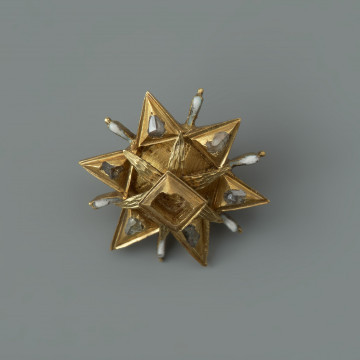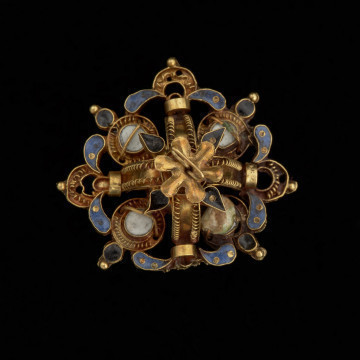
Three-piece pendent buckle of Duke Casimir VI/IX (1557-1605)
około 1600
National Museum in Szczecin
Part of the collection: Jewels and costumes of Pomeranian dukes
The embroidered cap is one of the most intriguing relics excavated from the crypt of the Castle Church in Szczecin. In 1862, when the crypt was visited for renovation work, the sarcophagus was opened, mistakenly believed to belong to Duke Francis I of Pomerania. The headdress was taken out of it and given to the Society of History and Antiquities of Pomeranian collections. In 1946, after the opening of the real sarcophagus of Duke Francis, with complete equipment, including the cap decorated with jewels, the 19th-century hypothesis collapsed. Unfortunately, neither the descriptions of the funeral ceremonies nor the known dukes’ portraits have, so far, made it possible to solve the mystery of to whom this extraordinarily unique item of clothing belonged.The cap is one of the five such headgears, called caps in inventories, excavated from the dukes’ sarcophagi. It is the only one without a rim. Each of the four wedges is decorated with symmetrical embroidery in the form of floral motifs, in which carnations and other stylised flowers, and silhouettes of deer, are interwoven. The present colouring of the cap, uniformly golden, has little in common with its former appearance. The outline of the ornament was originally intensely golden as it was made with thick threads with a braid of gilded silver. The design was complemented by embroidery made with coloured silk and pearls. Even today, it is possible to discern differences in the shades of thread filling the carnation flowers since it is lighter in the centre and darker, reddish in the upper and lower parts of the petals, and with a greenish reflection inside some of the leaves. Such embroidered floral motifs, made with multicoloured silk threads, and those with a metal braid, were very fashionable in northern Europe at the end of the 16th and the first quarter of the 17th century.
Monika Frankowska-Makała
Author / creator
Dimensions
cały obiekt: height: 22,5 cm, diameter: 28 cm
Creation time / dating
Creation / finding place
Identification number
Location / status

około 1600
National Museum in Szczecin

nie po 1637
National Museum in Szczecin

nie po 1637
National Museum in Szczecin
DISCOVER this TOPIC
Castle Museum in Łańcut
DISCOVER this PATH
Educational path